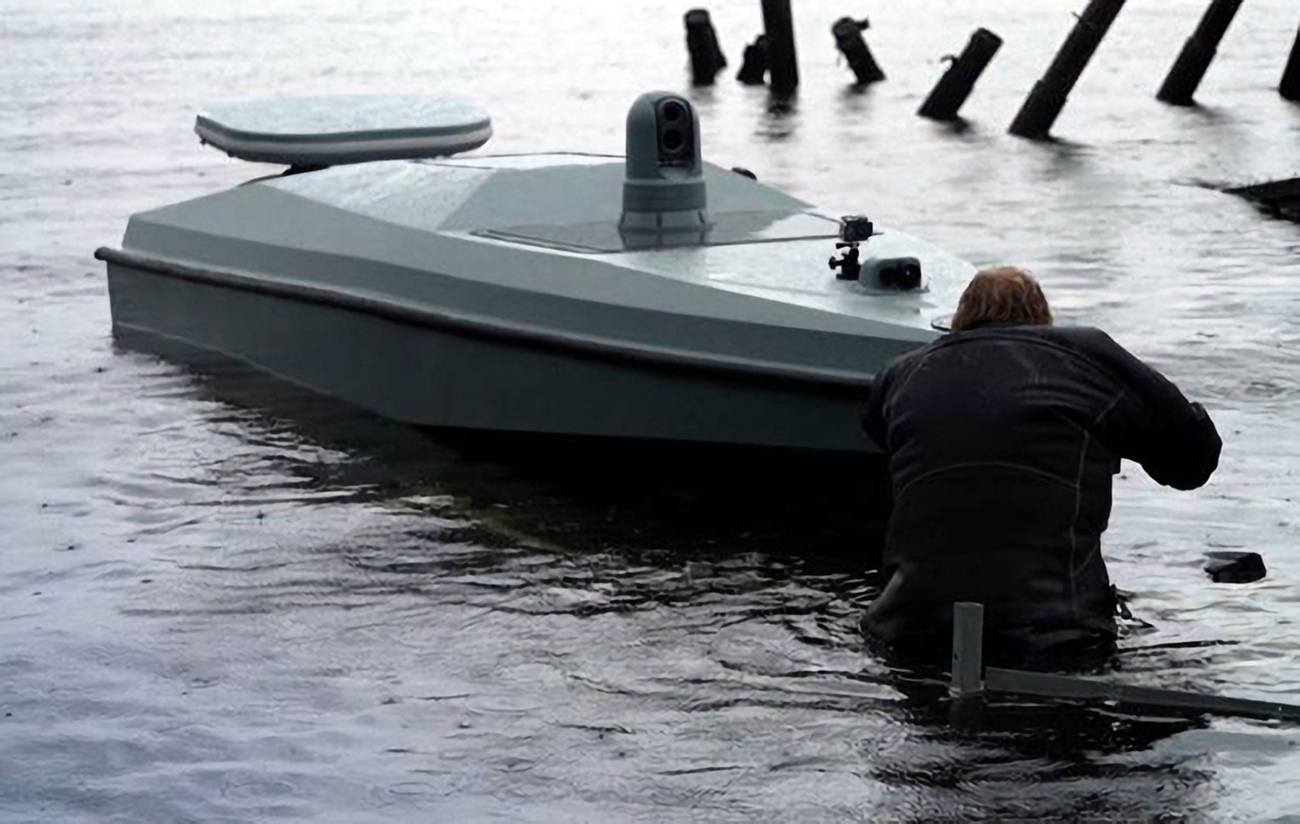Magura vs. Sea Baby: Closer look at Ukrainian drone warfare against Russian ships
 The maritime drone Sea Baby (Photo: t.me/SBUkr)
The maritime drone Sea Baby (Photo: t.me/SBUkr)
Ukrainian forces sank the Russian patrol ship Sergey Kotov this week. According to estimates, over the past two years, more than a third of the Russian Black Sea Fleet has been destroyed or damaged, including due to the advanced drones Magura and Sea Baby.
More about these developments, their characteristics, and how they have already changed the rules of warfare at sea can be found in the material by RBC-Ukraine.
The material was prepared using information from Wikipedia, statements from the Chief of the Defense Intelligence of the Ministry of Defense of Ukraine, Kyrylo Budanov, the spokesperson of the Ukrainian Navy Dmytro Pletenchuk, the head of the Security Service of Ukraine (SSU) Vasyl Maliuk, and the Spokesperson of the Security Service of Ukraine Artem Dekhtiarenko, as well as comments from the naval expert of Defence Express Volodymyr Zablotskyi.
Content
- Brainchild of the Ukrainian intelligence. What is known about Magura V5: characteristics and targets hit
- Sea Baby from the Security Service of Ukraine. Why Sea Baby is needed and what the new generation is capable of
- Magura or Sea Baby? Which naval drone is better
- How many ships are in the Black Sea and is there a limit to the combat readiness of the Russian fleet
Brainchild of the Ukrainian intelligence. What is known about Magura V5: characteristics and targets hit
On the morning of March 5th, several Magura V5 drones sequentially attacked the patrol ship Sergey Kotov in the area near the occupied Kerch. As a result, it sank. It is noteworthy that this was the last of the ships handed over to the Russian Black Sea Fleet in the summer of 2022. Currently, three such vessels remain in service - Vasyl Bykov, Dmytro Rogachov, and Pavlo Derzhavin, while two more - Viktor Velikiy and Nikolay Sipyagin - are being prepared for launch.
Magura drones first attacked Sergei Kotov back in August 2023, 340 km from Sevastopol, managing to sink it within five months. But this is far from the only target hit. In February, they sank the large landing ship Tsezar Kunikov near Alupka, the missile boat Ivanovets, and several landing boats. Additionally, in May, a reconnaissance ship Ivan Khurs was successfully attacked 140 km from the Bosporus.
The history of Ukrainian maritime drones began in the fall of 2022 with the announcement of a combat UAV with a range of up to 800 km. The first development was showcased at the International Defence Industry Fair (IDEF) 2023 in Istanbul.Sea Baby from the Security Service of Ukraine. Why Sea Baby is needed and what the new generation is capable ofInitially, the Security Service of Ukraine showed interest in the drone and collaborated with a private company. However, later, they pursued their own project, which eventually evolved into Sea Baby. Subsequently, the Defense Intelligence of the Ministry of Defense got involved, leading to the development of Magura V5. A report by CNN in July 2023 confirmed that the kamikaze boat was ready for deployment.
Magura V5 is a multi-purpose surface vessel capable of surveillance, reconnaissance, patrol, search and rescue operations, and combat missions.
 Photo: surface drone Magura V5 (screenshot from video)
Photo: surface drone Magura V5 (screenshot from video)
"This is an affordable solution that can be easily launched from any remote location. Unmanned control reduces the need for human resources to a minimum, reducing potential mortality in harsh conditions," say the developers.
The hydrodynamic hull and sleek profile allow the drone to move stealthily and with excellent maneuverability.
Key characteristics:
- length - 5.5 m
- width - 1.5 m
- mass - 1000 kg
- height above the waterline - 500 mm
- cruising speed - 22 knots (40.7 km/h)
- maximum speed - 42 knots (77.8 km/h)
- range - 450 nautical miles (approximately 833 km)
- payload - 320 kg
- communication - Mesh radio with airborne retransmitter or satellite communication
Magura is equipped with an autopilot system, video subsystems including night vision, backup communication modules, and combat components. It has autonomy of up to 60 hours, with a cost estimated at 10 million hryvnias.
Recently, the Chief of military intelligence, Kyrylo Budanov, announced that the drone was specifically designed to hunt down Russian ships. According to him, work is currently underway to enhance Magura's capabilities. For example, to install air defense systems (ADS) on an unmanned platform. Given that it is necessary to deploy detection, targeting, and engagement systems, this task is technically challenging, but, according to Budanov, feasible.
Sea Baby from the Security Service of Ukraine. Why Sea Baby is needed and what the new generation is capable of
In July 2023, the Security Service of Ukraine (SSU) and the Navy conducted a joint operation during which drones blew up two spans of the Crimean Bridge. And in early August, the large landing ship Olenegorsky Gornyak (near the port of Novorossiysk) and the tanker SIG were hit.
It became known that these targets were attacked by the latest drone, Sea Baby. According to the head of the SSU, Vasyl Maliuk, this is a unique development, produced in underground premises, and Ukrainian specialists - IT specialists, engineers, and others - are working on it.
 Photo: Sea Baby drones of the first generation (ssu.gov.ua)
Photo: Sea Baby drones of the first generation (ssu.gov.ua)
Unlike Magura, detailed characteristics of Sea Baby are not publicly available. However, it was reported about at least two modifications. In particular, the strikes on the bridge were carried out by drones equipped with combat units weighing 850 kg, and on the ship and tanker - with combat units weighing 450 kg.
As SSU spokesman Artem Dehtiarenko pointed out, at the beginning of the full-scale invasion, Russia dominated the water, controlled the coastline with fire, and blocked the grain corridor. Therefore, drone prototypes appeared in 2022 and then first struck targets in Sevastopol Bay - frigates Admiral Makarov and Admiral Essen, a minesweeper, and a patrol ship. Subsequent attacks in 2023 were already carried out using Sea Baby.
In particular, in the fall and winter, they were involved in attacks on the small missile ship Samum, the patrol ship Pavel Derzhavin, the tug Professor Nikolay Muru, and the minesweeper Vladimir Kozitsky. It was then that information appeared that drones had transformed from kamikaze into a multi-purpose platform, and the development philosophy became the decomposition of a combat ship into separate elements: means of air defense, striking and protection, which are installed on separate unmanned boats.
"We are using asymmetric approaches, where a drone worth 8.5 million hryvnias destroys a military ship worth several tens of millions of dollars," Dehtiarenko said.
In January, a drone equipped with 2-6 jet flamethrowers similar to disposable grenade launchers with thermobaric ammunition RPV-16 was presented. In February, the UNITED24 Foundation, together with partners, launched a fundraising campaign for the production of 35 units of Sea Baby-2024, raising almost 300 million hryvnias, and recently presented the first sample to the general public, which is positioned as a drone of a new generation.
"It has its own name, as is usually the case with full-fledged combat ships. We called it Avdiivka. This is like a reminder to the enemy about the destroyed Ukrainian city and a symbol of what Russia can expect," Dehtiarenko said.
According to him, Sea Baby-2024 is even more advanced and more deadly for the enemy. It differs from the previous model both in appearance and characteristics. For example, it is capable of delivering almost 1000 kg of explosives over a distance of more than 1000 km.
"This means that the SSU will be able to reach enemy targets practically anywhere in the Black Sea. It is currently undergoing full testing... (it will - Ed.) integrate advanced onboard weapons and work out all technical nuances. Of course, we cannot disclose further plans for obvious reasons. But the SSU guarantees that this year will be very hot for the Russians, not only regarding the Crimean Bridge, which, according to him, is already doomed," the spokesman added.
Interestingly, judging from the published footage, Starlink satellite internet is used for communication with the maritime drone Avdiivka.
Magura or Sea Baby? Which naval drone is better
The guidance and control system is the same for both Magura and Sea Baby, says military-naval expert Volodymyr Zablotskyi of Defence Express. The difference lies in the dimensions, mass of the combat payload, and, accordingly, in the purpose.
"Magura is a specialized anti-ship unmanned vessel. It carries a payload of 200 kg, two bombs of 100 kg each, which is enough to sink ships. Sea Baby, roughly speaking, is an enlarged copy, 6 meters in length and wider. It carries more explosives, and in my opinion, it is exclusively intended for blowing up the Crimean Bridge," he notes in a comment to RBC-Ukraine.
According to him, the Olenegorsky Gornyak and the tanker SIG were attacked by a simplified version called Kozak (Cossack) Mamai. It carries over 400 kg of explosives, is high-speed, and is armored. However, as the experience with Sergei Kotov and Tsezar Kunikov has shown, even unarmored Magura successfully damages ships whose crews try to resist with automatic weapons or artillery guns.
Therefore, it is incorrect to say which is better - Magura or Sea Baby.
_1.jpg) Photo: Sea Baby could become a bridge killer (t.me/SBUkr)
Photo: Sea Baby could become a bridge killer (t.me/SBUkr)
"Sea Baby is a bridge killer. The drones are different in purpose, it's like comparing a truck to a Mercedes," adds the expert.
Nevertheless, both drones have already played an important role in the fight against the Russian fleet in the Black Sea, says a spokesman for the Navy Dmytro Pletenchuk.
"Many strikes have been made thanks to unmanned combat systems. I can say that this weapon can be classified as a game-changer. That is, a type of weapon that has changed the rules of the game. And in this sense, Ukraine is a world leader in the use of unmanned systems today," he said at yesterday's briefing.
SSU representative Artem Dehtiarenko notes that part of the special operations is carried out with the Navy, and as for the brothers-in-arms from the Defense Intelligence, they are also always pleased with their successes.
"We have a common goal - to destroy the enemy, so we all actively cooperate. There is no talk of competition," he adds.
Naval drones have changed the rules of the game in the sense that Ukraine, without having a full-fledged fleet, was able to destroy part of the Russian fleet and drive most of the ships away from the occupied Crimea. But this does not mean that the fleet is not needed at all.
"Ukraine plays asymmetrically and wins. However, no drones can replace a ship; there are tasks that they are not capable of. This is just a weapon like a torpedo, bomb, or missile. They cannot land troops. They cannot go to distant waters, for example, to the Mediterranean Sea, where the fleets of (future allies of Ukraine - Ed.) NATO operate and solve global issues," Zablotskyi explains.
How many ships are in the Black Sea and is there a limit to the combat readiness of the Russian fleet
The results of the recent strikes are evident - Russian ships are forced to stay in the eastern part of the Black Sea, dispersing between ports in Novorossiysk, Sochi, and Tuapse. As for the occupied Sevastopol, their presence there has been minimized. According to Pletenchuk, only a few units enter there for various reasons.
Over the past two years, it has been possible to end Russia's dominance in the western part of the Black Sea, including unblocking the grain corridor. The threat of missile strikes from the Black Sea has significantly decreased, but still exists.
"We still have a lot of work ahead, so we plan special operations, destroy enemy military objects, disrupt logistical arteries, continue working, and move closer to victory. Destroying the Black Sea Fleet of the Russian Federation is a very difficult but achievable task. Usually, the SSU talks about its plans when results are achieved. So instead of predictions, we will do our job: we will destroy the enemy by any means on land and at sea," said SSU spokesperson Dehtiarenko, recalling Maliuk's words that after all missile carriers are eliminated, attention will shift to submarines.
 Photo: Despite significant losses, the Russian Black Sea Fleet remains a threat to Ukraine (mil.ru)
Photo: Despite significant losses, the Russian Black Sea Fleet remains a threat to Ukraine (mil.ru)
Pletenchuk provides the following statistics: out of the total number of Russian fleet units in the Black Sea, about 80 units have been destroyed, and many more ships have been damaged. Irreversible losses amount to 27 units, including 14 serious vessels, among them large landing ships, missile boats, the submarine Rostov-on-Donu, and a patrol ship. Fifteen ships are damaged and undergoing repairs.
"However, the presence is quite serious - there are 10 missile carriers (including three submarines), 2 missile boats, and several patrol and guard ships. Also, there are five large landing ships in service (four under repair). I can say that the grouping in the Azov-Black Sea region is quite serious," he emphasized.
Obviously, the Russian fleet is approaching a critical point. There is an opinion that about a dozen more ships need to be destroyed, and the Russian Black Sea Fleet as such will cease to exist. However, expert Volodymyr Zablotskyi is cautious in his assessments, including because the aggressor manages to replenish the ship composition.
"They use factories in the occupied Kerch and Feodosia. The same Sergei Kotov and two other ships were built there, two more are under construction. They are building small missile ships of the Karakurt type. They also transfer ships from the Caspian Sea and Zelenodolsk (Tatarstan, where there is a shipyard on the Volga - Ed.). They definitely received about a dozen ships in the Black Sea during the war," he notes in a conversation with the news agency.
It should be noted that from the Caspian Sea and Zelenodolsk, the Russians transfer ships through inland waterways via the Volga-Don shipping canal to the Sea of Azov. In addition, the Black Sea Fleet is assisted by FSB ships, of which there are many, and they are involved in aggression.
Speculating about the combat readiness of the Russian Black Sea Fleet and how many need to be sunk to reduce it to zero can only be relative. Ideally, to start, it would be to finish off the remaining 10 missile carriers, including three submarines. How to destroy them is still unclear. The same Rostov-on-Donu was hit by a Storm Shadow missile while undergoing repairs in Sevastopol.
"I can't say anything here, but I know that our people are working on it. Maybe there will be some underwater drones. Or they will attach torpedoes to them, we'll see," says Zablotskyi.
The fact is that today the Black Sea Fleet of the Russian Federation is capable of only one task - conducting missile strikes. And it can no longer go beyond Cape Tarkhankut to the west, as there is a zone of Ukrainian missile strikes, adds the expert.

